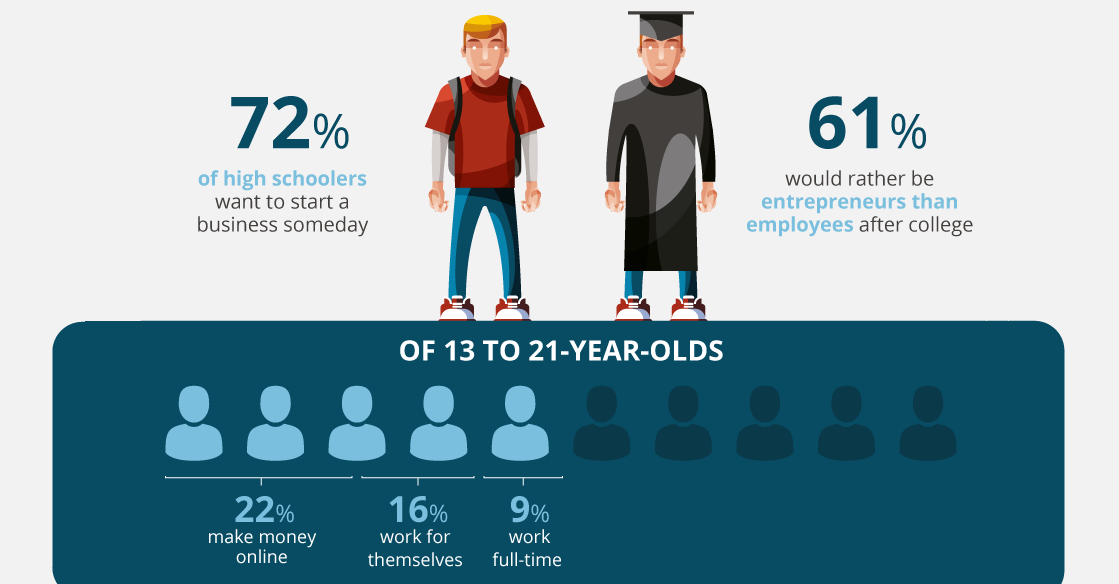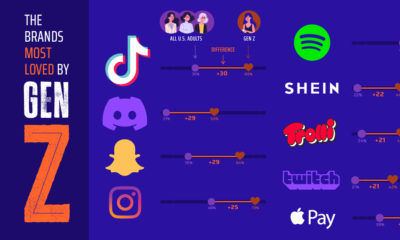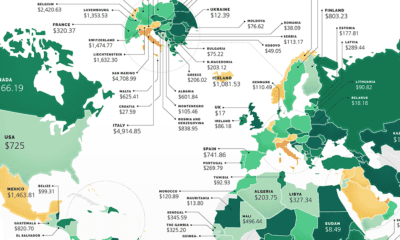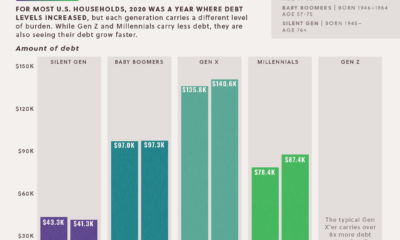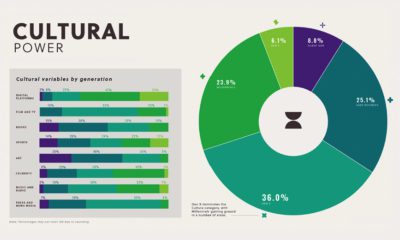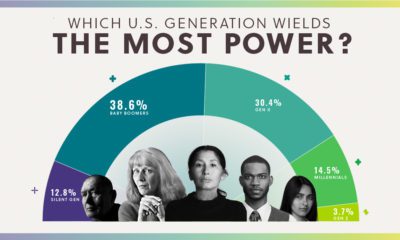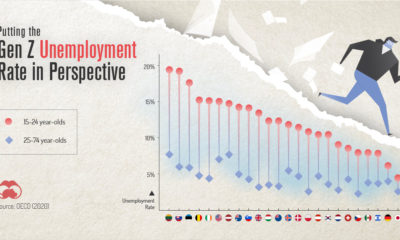But for young entrepreneurs, especially those in Gen Z (born after the year 2000), running a business can have even more complications that make it difficult to get basic tasks done. Whether it’s credit card age limitations or simply not being taken seriously by employees or vendors, young entrepreneurs must find ways to overcome these business challenges.
Identifying the Pitfalls
Today’s infographic comes to us from Insurance Quotes, and it identifies the pitfalls encountered by young entrepreneurs as well as some of youth’s most important advantages.
Millennials, in comparison to the generation before them, have been less entrepreneurial as a whole. In fact, only 24% of 20-34 year olds today are new entrepreneurs, compared to a 34% rate from two decades ago. Gen Z, however, is looking to take the reins – and now, 72% of high schoolers say they want to start a business someday.
Pitfalls for Young Entrepreneurs
Despite this increased interest in entrepreneurship, Gen Z faces significant pitfalls that must be overcome: Age Limits Many small businesses use credit cards or bank loans for day-to-day purposes, whether they are for picking up small expenses, growth capital, or as cash flow buffers. However, in the United States, you must be 21 years old to get a credit card without a cosigner or proof of regular income. For bank loans, that age requirement drops to 18, but even then a cosigner or good credit is usually required. In the same vein, age restrictions can also make it hard for young people to network, since many conferences or events take place in licensed establishments like bars or casinos. Age Discrimination Vendors, colleagues, and employees may not take young entrepreneurs seriously. Sometimes stereotypes of young people being a certain way may persist, as well. Passing Class Young entrepreneurs must divide time between business and school, creating competing priorities. Rookie Mistakes Inexperience can also be an early enemy for young entrepreneurs – hiring friends (instead of qualified people), micromanaging, being overprotective of new ideas, or mixing business and personal finances can be just some mistakes made from a lack of experience.
Advantages of Youth
Despite the list of potential pitfalls, it’s also clear that youth can provide big benefits to an up-and-coming business owner. Firstly, the barriers to entry of business today are lower than ever before. It’s now possible to sell almost anything online for next to nothing, and Gen Z is inherently knowledgeable when it comes to exploiting any new technologies. Next, without families to provide for or mortgages to pay, young people also typically have fewer responsibilities. This sets them up to take on risks that might steer away more seasoned businesspeople. Lastly, a lack of experience can also be a massive advantage if used correctly. Young people have no preconceptions of “how things should be”, and can use that to pull off new ideas that others simply couldn’t imagine. This naiveté is arguably a big part of how today’s modern giants like Airbnb and Facebook came to be.
on Even while political regimes across these countries have changed over time, they’ve largely followed a few different types of governance. Today, every country can ultimately be classified into just nine broad forms of government systems. This map by Truman Du uses information from Wikipedia to map the government systems that rule the world today.
Countries By Type of Government
It’s important to note that this map charts government systems according to each country’s legal framework. Many countries have constitutions stating their de jure or legally recognized system of government, but their de facto or realized form of governance may be quite different. Here is a list of the stated government system of UN member states and observers as of January 2023: Let’s take a closer look at some of these systems.
Monarchies
Brought back into the spotlight after the death of Queen Elizabeth II of England in September 2022, this form of government has a single ruler. They carry titles from king and queen to sultan or emperor, and their government systems can be further divided into three modern types: constitutional, semi-constitutional, and absolute. A constitutional monarchy sees the monarch act as head of state within the parameters of a constitution, giving them little to no real power. For example, King Charles III is the head of 15 Commonwealth nations including Canada and Australia. However, each has their own head of government. On the other hand, a semi-constitutional monarchy lets the monarch or ruling royal family retain substantial political powers, as is the case in Jordan and Morocco. However, their monarchs still rule the country according to a democratic constitution and in concert with other institutions. Finally, an absolute monarchy is most like the monarchies of old, where the ruler has full power over governance, with modern examples including Saudi Arabia and Vatican City.
Republics
Unlike monarchies, the people hold the power in a republic government system, directly electing representatives to form government. Again, there are multiple types of modern republic governments: presidential, semi-presidential, and parliamentary. The presidential republic could be considered a direct progression from monarchies. This system has a strong and independent chief executive with extensive powers when it comes to domestic affairs and foreign policy. An example of this is the United States, where the President is both the head of state and the head of government. In a semi-presidential republic, the president is the head of state and has some executive powers that are independent of the legislature. However, the prime minister (or chancellor or equivalent title) is the head of government, responsible to the legislature along with the cabinet. Russia is a classic example of this type of government. The last type of republic system is parliamentary. In this system, the president is a figurehead, while the head of government holds real power and is validated by and accountable to the parliament. This type of system can be seen in Germany, Italy, and India and is akin to constitutional monarchies. It’s also important to point out that some parliamentary republic systems operate slightly differently. For example in South Africa, the president is both the head of state and government, but is elected directly by the legislature. This leaves them (and their ministries) potentially subject to parliamentary confidence.
One-Party State
Many of the systems above involve multiple political parties vying to rule and govern their respective countries. In a one-party state, also called a single-party state or single-party system, only one political party has the right to form government. All other political parties are either outlawed or only allowed limited participation in elections. In this system, a country’s head of state and head of government can be executive or ceremonial but political power is constitutionally linked to a single political movement. China is the most well-known example of this government system, with the General Secretary of the Communist Party of China ruling as the de facto leader since 1989.
Provisional
The final form of government is a provisional government formed as an interim or transitional government. In this system, an emergency governmental body is created to manage political transitions after the collapse of a government, or when a new state is formed. Often these evolve into fully constitutionalized systems, but sometimes they hold power for longer than expected. Some examples of countries that are considered provisional include Libya, Burkina Faso, and Chad.

